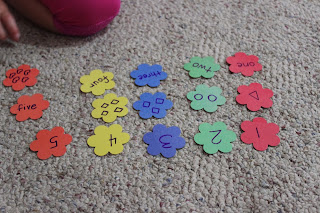Activity: Sorting marker lids by color
Learning Materials: assorted marker lids (any small item that comes in a variety of colors will work), cups for sorting (we use yogurt cups)
Directions:
1) Sort the lids by color
2) Count how many different groups there are
Extended Activities (when ready)
1) Compare the groups with the most/fewest lids
2) Count how many lids are in each group
3) Sort the lids by size
Even further extension (older students)
1) Chart on a graph how many colors are in each group
2) Add two groups together
3) Find the difference between two groups
 |
| N is sorting the marker lids by color |
 |
| I let N choose which color some of the lids were as they could have gone in different groups. |
 |
| Counting which group had the most. |
Kansas Early Learning Standard: Math Pre-4 (by 60 months)
Classify objects and count the number of objects in each category
M.MD.p4.3: Sorts objects into categories, counts the number of objects in each category, makes comparisons between the categories based on quantity.
Counting and Cardinality
MCC.p.4.1: Counts in sequence to 30
Count to tell the number of objects
MCC.p.4.4a: Uses one-to-one correspondence when counting the objects
Compare Numbers
MCC.p4.6: Identifies whether the number of objects in one group is greater than, less than, or equal to the number of objects in another group


















